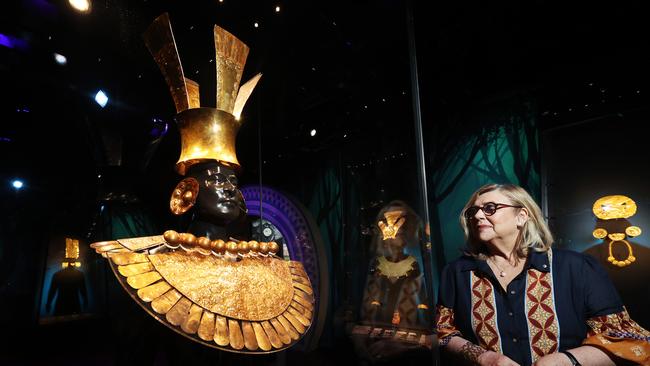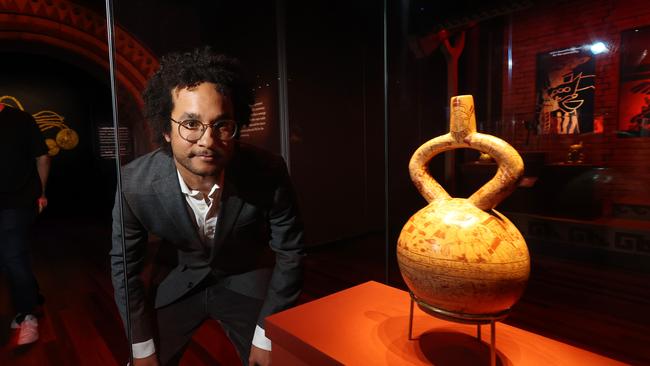Bucket list comes to us: Machu Picchu magic on show right here in Australia
Magnificent gold crowns, ceremonial cups used in human sacrifices, and a virtual flight off an Inca citadel: Machu Picchu and the Golden Empires of Peru exhibit comes to the Australian Museum.

Usually to get to Machu Picchu from Sydney it takes a 20-hour plane ride to Lima, a further flight to Cusco, a 74km trip by car and train to Aguas Calientes, and a hike or bus trip up the mountain.
But Australian Museum director Kim McKay says “if you can’t get there”, the virtual reality experience within the Machu Picchu and the Golden Empires of Peru exhibit “will take you” to the mountain top, before you experience the “mystery and culture” of the 15th century Inca citadel through its ancient artefacts.
“Museums now have to be more than putting an object on display, as beautifully as it’s presented, and some wording beneath it. You have to give the visitor a true experience, something that is very memorable. And I think with some of these ancient cultures, the story told through virtual reality does evoke that,” Ms McKay says.
The major summer exhibition at the Australian Museum, which features 134 treasures – many made of pure gold, silver and gilded copper – follows last summer’s blockbuster Ramses & the Gold of the Pharaohs exhibition, which attracted 508,000 people through the doors. “If we get half of that … it would be a significant exhibition,” Ms McKay says. And, as with Egypt, she says “our research showed that Australians are fascinated by Machu Picchu”.
“The biggest challenge for cultural institutions … is being a sustainable enterprise, and you don’t want to have a year of success and then 10 years of no success. The way you do that is you really understand your audience … what they’re looking for. We don’t make calls about what we’re going to have by accident.”
The new exhibition looks at the religious beliefs and rituals, royal power, trade and agriculture and the eventual decline of the mysterious ancient culture. It includes stories of mythological superhero and leader of the Moche, Ai Apaec, displays of magnificent gold crowns and jewellery, and ceremonial cups used in human sacrifice.
Ms McKay has been to Machu Picchu three times, including once on a National Geographic project to locate underground mummy bundles, and says “the exhibition can take you back to 3000 years of culture”.

Sydney University archaeologist Jacob Bongers, who worked in Peru for more than 10 years, says the exhibit does a good job of bringing ancient Peru to life.
“What the public is going to see are some of the highest-quality pottery and metal objects in the Americas. These are masterpieces,” he says.
“And one thing that I do want to note, there are some people who think, how could these objects have been made, they’re so amazing, they must have had help from aliens or some lost technology. It’s all false. These objects show the high technical skill of these indigenous communities.”
He showed The Australian one ceramic cup from 100 to 800 C.E. which depicts human sacrifices that may have occurred.
“You have a prisoner who is bound, their throat is being slit, and the blood is being collected into a goblet. What’s so amazing is that some of the objects you see in the scene – goblet, headdresses and so forth – have been found on digs. So, what we’re seeing may have actually happened.”
Read a feature on the exhibition – which opens to the public on Saturday – in the Review liftout in The Weekend Australian





To join the conversation, please log in. Don't have an account? Register
Join the conversation, you are commenting as Logout